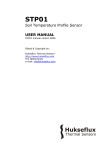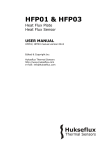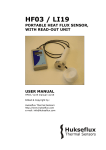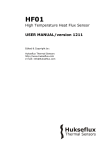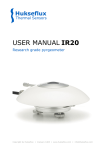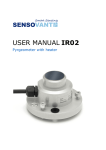Download TP01 Manual version 1509
Transcript
TP01 Thermal Properties Sensor USER MANUAL INCLUDING THERMAL DIFFUSIVITY AND VOLUMETRIC HEAT CAPACITY MEASUREMENT TP01 Manual version 1509 Edited & Copyright by: Hukseflux Thermal Sensors http://www.hukseflux.com e-mail: [email protected] Hukseflux Thermal Sensors Warning: Putting more than 2 volts across the heater of TP01 may result in permanent damage to the sensor In case of supply from a 12VDC source, typically a 150 Ohm resistor must be put in series with the TP01 heater. This is the user’s responsibility. TP01 Manual version 1509 page 2/45 Hukseflux Thermal Sensors Contents 1 2 3 4 5 6 7 8 9 10 11 11.1 11.2 11.3 11.4 11.5 11.6 11.7 11.8 11.9 List of symbols Introduction Theory Theory for meteorological applications Specifications of TP01 Short user guide Putting TP01 into operation Installation of TP01 Maintenance of TP01 Requirements for data acquisition and control Electrical connection of TP01 Programming for TP01 Appendices Appendix on calibration of TP01 Appendix on agar gel Appendix on cable extension for TP01 Appendix typical thermal properties Appendix trouble shooting Appendix on use in media of low thermal conductivity Theory of TP01 extended Comparison of TP01 to conventional probes CE declaration of conformity TP01 Manual version 1509 4 5 8 14 16 18 19 21 22 23 24 25 28 28 28 29 29 30 32 35 43 45 page 3/45 Hukseflux Thermal Sensors List of symbols Thermal diffusivity Distance from the heater Heating cycle time Heating power per meter Intermediate variable Thermal conductivity Voltage output Sensitivity of the thermopile for temp. gradients Sensitivity for the thermal conductivity Effective sensitivity for thermal conductivity Time Response time Temperature Differential temperature Electrical resistance Effective length of the heater Electrical resistance per meter Volumetric heat capacity Heat capacity Density Water content on mass basis Water content on volume basis Heat flux Storage term Depth below the soil surface a r H Q q U ET E E t T T Re L Rem Cv C m v S d m2/s m s W/m W/mK V V/K V/K V/Km s s K K m /m J/K.m3 J/kg kg/m3 kg/kg m3/m3 W/m2 W/m2 m Subscripts Property of thermopile sensor Properties of the heater Property of the reference medium Property of the hot joints Property of the cold joints Property, at t = 0, at t = 180 seconds Property of dry soil Property of water Measurement done at the 63% response time Measurement done by a heat flux sensor TP01 Manual version 1509 sen heat ref h c 0, 180 d w 63% heat flux page 4/45 Hukseflux Thermal Sensors Introduction The TP01 is a sensor for the long-term monitoring of soil thermal conductivity, thermal diffusivity and heat capacity. Because of its unique sensor principle it is extremely fast, and has easy signal interpretation. It is based on a differential temperature sensor with record-breaking sensitivity and extremely low thermal mass. TP01 is designed for long-term (permanent) installation in soils. It covers the thermal conductivity (λ) range of 0.3 to 5 W/mK, which is sufficient for most inorganic soil types. Main applications are found in soil physics, agricultural meteorology, soil energy balance monitoring. Additional applications can be found for modelling of local conditions for oil pipelines and high voltage electrical cables. TP01 serves to estimate the so called “storage term ". A typical TP01 is incorporated in a meteorological system, in which also wind, humidity, heat flux and radiation are measured. Application of TP01 takes away the necessity to separately analyse soil samples for their thermal properties. It is no longer necessary to use the soil moisture measurement to determine the storage term. On the other hand, the TP01 measurement can be used as a redundant measurement for the soil moisture; the heat capacity is a linear function of the heat capacity. During measurement the control and data storage are typically taken care of by a data logging and control system. TP01 Manual version 1509 page 5/45 Hukseflux Thermal Sensors The core of TP01 is a differential temperature sensor (2 thermopiles) (1) measuring the radial differential temperature with record breaking sensitivity. The sensor performs a temperature measurement around a heating wire (2). Both heating wire and sensor are incorporated in a very thin plastic foil. The low thermal mass makes it suitable for estimating thermal diffusivity (a). Dividing λ by the thermal diffusivity a gives the volumetric heat capacity Cv, which varies with water content. The thermopile signal minus the initial offset (U - U0) when heating with power Q depends on λ and a of the medium. U - U0 = ( Eλ Q / λ ) F( a t ) Eλ is a calibration constant, t is time, F is a function that equals 1 for large at. By looking at the steady state signal amplitude λ can be determined. Cv and a can be found by looking at the 63% response time for F. The detection of changes in Cv (and water content) is the strong point of TP01; the resolution is much better than the accuracy. The product manual can be obtained via e-mail. Programs for use with the Campbell Scientific CR10X and CR1000 are available. Hukseflux has a broad product range of sensors for thermal conductivity measurement; please consult the product catalogue. TP01 is a design is completely new. Development of this measurement method was done at Hukseflux. TP01 Manual version 1509 page 6/45 Hukseflux Thermal Sensors 20 20 60 0 .1 5 1 4 3 1. 2. 3. 4. 5. 6. λ < λ1 , a > a1 λ = λ1 , a < a1 V λ > λ1 , a = a1 t V ~ 1 /λ t ~ a Figure 0.1 above: TP01 sensor: thermopiles (1), heating wire (2), cable (3). Dimensions in mm. Below: graphs in different soil types: signal amplitude varies with 1/ λ, signal response time varies with a. All dimensions are in mm. The general measurement principle is to look at the sensor response when the heater is switched on. At a certain heating power, large signals indicate a soil with low thermal conductivity . The sensor response time, is proportional to the soil thermal diffusivity a. The division of by a gives the volumetric heat capacity Cv. TP01 Manual version 1509 page 7/45 Hukseflux Thermal Sensors 1 Theory The following chapter gives a summary of the TP01 theory. A more extensive explanation can be found in an appendix of this manual. As indicated in the introduction, the TP01 design is a modification of the well known non-steady-state probe. This technique utilizes the temperature measurement around a heating wire to analyze soil properties. All non-steady-state probes are based on the same phenomenon: that one can determine the thermal properties of a medium from the temperature response to heating. After an initial transition period, the temperature rise close to the heater depends only on the thermal conductivity of the surrounding medium, and no longer on heat capacity. This method avoids the necessity to reach a true thermal equilibrium with constant temperatures. Non-steady-state techniques are fast and also there is no need for careful sample preparation. Sensors based on this principle are therefore suitable for quick experiments and also for field use. Provided that the thermal mass of the sensor itself is small, during the initial transition period the time response of this type of probe is proportional to the thermal diffusivity of the surrounding medium. TP01 uses a new technique which depends heavily on a very sensitive temperature gradient sensor. A differential temperature sensor (2 thermopiles) measures the radial differential temperature around the central heating wire with recordbreaking sensitivity. This technique is easier to employ than conventional techniques because the interpretation of the signals is very easy. The principle of measurement is clarified in figures 0.1, 1.1 and 1.2. TP01 Manual version 1509 page 8/45 Hukseflux Thermal Sensors A thermopile essentially is a number of thermocouples in series. A thermocouple delivers an output signal that is proportional to the differential temperature between the hot joints and the cold joints. Multiple thermocouples in series, a thermopile, will produce a proportionally larger signal. In case of TP01 the hot joints are located near the heating wire (at 1 mm distance, rh ) and the cold joints are located far away from the heater (at about 5 mm, rc). There are two rows of each 20 thermocouples (copper – constantan) , which results in a signal of about 1,6 mV when the medium at 1 mm from the heater differs 1 degree Celsius from the medium at 5 mm from the heater. This sensitivity is not equalled by any other sensor that is known to us. It opens the possibility to reduce the sensor dimensions considerably and to use low heater power, which is essential for accurate measurements in humid soils. In humid soils (so not saturated and also not perfectly dry) it is recommended that the heater power remains low to avoid local transport of moisture by evaporation. The 0.8 W/m of TP01 is the recommended maximum. TP01 Manual version 1509 page 9/45 Hukseflux Thermal Sensors A voltage signal U is generated by the thermopile sensor, driven by the differential temperature around the heating wire. This can be seen in figure 1.1. It gives a top view of the sensor and the surrounding soil when heating. The heating wire generates a circular temperature field. After some minutes, the temperature difference around the sensor becomes stable. λ << λ >> T3 T1 1 2 T2 T2 T1 3 4 5 Figure 1.1 Top view of the radial temperature distribution (with isotherms (3)) around the heating (2) wire of TP01 (1) in two different media; right high thermal conductivity, left low thermal conductivity. The thermopiles measure the difference between the temperature at rh (4) and rc (5). TP01 Manual version 1509 page 10/45 Hukseflux Thermal Sensors The result is a sensor which reacts to a heating pulse in the following way: U - U0 = (E Q / ) F( a t ) 1.1 E is a calibration constant expressing the sensor sensitivity to thermal conductivity of the medium, t is time, F is a function that equals 1 for large t. By looking at the steady state signal amplitude, can be determined. The function F describes the speed at which the process takes place. This process scales with the thermal diffusivity of the medium. As the thermopile only extends to 6 10-3 m from the heater, and the worst-case value for thermal diffusivity is 0.1 10-6 m2/s, the stabilisation of the differential temperature typically takes 180 seconds. Formula 1.1 shows that the pulse response of the sensor signal scales with Q / for the amplitude, and with a for the time response. By curve fitting F one can find a. One of the easiest ways of doing this is looking at the 63% response time of the measurement. The common procedure is to first determine the thermal conductivity, and after the heating cycle to determine how much time it takes to fall by 63% of the amplitude towards the original signal level. When applying TP01 as a thermal diffusivity sensor, an essential feature is that both the heater and the thermopile are incorporated in a very thin plastic sheet, with extremely low thermal mass. This implies that the sensor itself does not play a significant role from a thermal point of view. The low thermal mass makes it suitable for estimating thermal diffusivity a without correcting for the sensor mass (contrary to some steel needle probes that have a relatively high mass). TP01 Manual version 1509 page 11/45 Hukseflux Thermal Sensors The central formula for using TP01 as a thermal conductivity sensor is valid after typically 3 minutes (180 seconds) of heating, when F equals 1: = E Q / (U180 - U0) 1.2 or = E (Uheat)2 / (U180 - U0) Re L 1.3 Re L and E are parameters that are given as part of the delivery. L is 0.06 m. = E , Re and L can be combined to one factor, so that one obtains: = Eeff (Uheat)2 / (U180 - U0) 1.4 with: Eeff = E / Re L 1.5 All one has to know is the sensor output voltage before and after heating for about 3 minutes, and the heater power. The heater power is typically calculated from the known heater resistance, also delivered with the sensor and the voltage across the heater. NOTE: in case current measurements are available, the above calculations may be re-written using Q = I2 Re L The sensor is calibrated for measurements of . See the appendix on calibration. Although formal calibration traceability is to international standards of NPL, in practice the reference medium is agar gel, see the appendix on agar gel. The calibration is valid for the range of 0.3 to 5 W/mK. In this range of thermal conductivity’s, the properties of the medium dominate over the sensor properties. When the thermal conductivity of the medium is lower, the thermal conductance of the sensor foil itself (particularly the copper), starts dominating. This results in a change of sensitivity, or non-linear behaviour. It is possible to work in a wider range, but one will have to work with a calibration curve. See the appendix on use of TP01 out of normal specifications. TP01 Manual version 1509 page 12/45 Hukseflux Thermal Sensors The recommended approach for using TP01 as a sensor for thermal diffusivity and volumetric heat capacity is to measure the signal amplitude U0 - U180 and to establish how much time it takes after switching the heater off, to return to U0+ 0.37 (U0 U180). (this is equivalent to the 63% response time 63%). The reference thermal diffusivity has been established in water. In this case aref is 0.14 10-6. Comparison to U to U0 - U180 Timing 63% a=a ref. ref, 63% / 63% 1.5 The calibration for thermal diffusivity is not done for each individual sensor; it largely depends on the sensor dimensions. The value can be found on the calibration certificate. It is the same for every sensor. Volumetric heat capacity is determined by: Cv = / a 1.6 It should be noted that the absolute accuracy of the measurement of the volumetric heat capacity is not very high. The power of TP01 is in detecting changes. The smallest meaningfully detectable change we call resolution. TP01 Manual version 1509 page 13/45 Hukseflux Thermal Sensors 2 Theory for meteorological applications There are several motives for using TP01. In meteorology, the main measurement objectives typically are: 1. using TP01 it is no longer necessary to separately take soil samples at every measurement location and analyze them for their thermal properties. 2. using TP01 it is no longer necessary to use the soil moisture measurement to analyze the storage term. 3. the TP01 measurement can be used as a redundant measurement for the soil moisture measurement. In meteorological measurements the heat flux at the surface is usually measured using a heat flux plate. This plate gives an output that is directly proportional to the heat flux through it. For various practical and theoretical reasons, the heat flux plate cannot be installed directly at the surface. The main reason is that it would distort the flow of moisture, and be no longer representative of the surrounding soil, both from a moisture and from a thermal/spectral point of view. Also in case of installation close to the surface, the sensor would be more vulnerable and the stability of the installation becomes an uncertain factor. For these reasons the flux at the soil surface, , is estimated from the flux measured by the heat flux sensor, heatflux , plus the energy that is stored in the layer above it, S. = heatflux +S 2.1 The parameter S is called the storage term. The storage term is calculated using an averaged soil temperature measurement combined with an estimate of the volumetric heat capacity (of the volume above the sensor. S = (T1-T2) Cv d / (t1-t2) 2.2 Where S is the storage term, T1-T2 is the temperature change in the measurement interval, Cv the volumetric heat capacity, d the depth of installation of the soil heat flux sensors, t1-t2 the length of the measurement interval in seconds. TP01 Manual version 1509 page 14/45 Hukseflux Thermal Sensors At an installation depth of 6 cm, the storage term typically represents up to 50% of the total flux . When the temperature is measured closely below the surface, the response time of the storage term measurement to a changing is in the order of magnitude of 20 minutes, while the heat flux sensor heatflux (buried at twice the depth) is a factor 4 slower (square of the depth). This implies that a correct measurement of the storage term is essential to a correct measurement of with a high time resolution. At present the volumetric heat capacity, Cv, is estimated from the heat capacity of dry soil, Cd, the bulk density of the dry soil d, the water content (on mass basis), m , and Cw, the heat capacity of water. Cv = d (C d + m Cw ) 2.3 The heat capacity of water is known, but the other parameters of the equation are much more difficult to determine, and are dependent on location and time. For determining bulk density and heat capacity one has to take local samples and to perform careful analysis. The soil moisture content measurement is difficult and suffers from various errors. TP01 gets around these problems by performing a direct measurement. This is a big advantage as such and sufficient reason for application in Bowen Ratio systems. Additionally the TP01 measurement is quite useful to create some redundancy for the soil moisture measurement that is often done in such systems. From 2.3 it can easily be seen that there is a direct relationship between the soil moisture and the volumetric heat capacity. m = (Cv / d - C d ) / Cw 2.4 The latter formula gives water content on a mass basis. For estimates on a volume basis, one has to multiply by b and divide by w: v = (Cv - C d d ) / w Cw 2.5 As the properties of water are quite well known, an error in will stem from errors in Cv and in d . TP01 Manual version 1509 page 15/45 Hukseflux Thermal Sensors 3 Specifications of TP01 TP01 Thermal properties sensor is intended for the long-term monitoring of soil thermal conductivity, thermal diffusivity and heat capacity. It can only be used in combination with a suitable measurement and control system. GENERAL SPECIFICATIONS Suitable Media Soils in the thermal diffusivity range (a) of 0.05 to 1 10-6 m2/s and the thermal conductivity () range of 0.3 to 5 W/mK Temperature range -30 to +80 °C Required heating aH must be of the order of magnitude of cycle time H 25.10-6 m2 or larger. (typ. 180 seconds) Required depth of Preferably the soil must be all around insertion TP01. The foil must be inserted for at least 45 mm Specified Thermal conductivity and thermal measurements diffusivity in the soils as specified under suitable media. The volumetric heat capacity (Cv) is a derived measurement: Cv = / a Non specified Use in fluids, pastes and gels and use for measurements determining thermal diffusivity is possible, but not specified. Use in media of lower than normal is possible after correcting for non-linear behaviour. (see appendices) CE requirements TP01 complies with CE directives MEASUREMENT SPECIFICATIONS Expected accuracy +/- 5% (for thermal conductivity measurements of suitable media) +/- 20% (for thermal diffusivity measurements of suitable media) Resolution of Cv 10 % Temperature + 0.15%/K ( measurement only) dependence Heating power 0.05 W typically during 180 s. When switched on every 3 hours from a 12 VDC supply using a 150 Ohm serial resistor, the actual power cunsption will be 0.9 Watt. The average power consumption will then be 0.015 Watt. Heating power / m 0.8 W/m (nominal) (1V, 20 ohm, 60 mm) (Q) Table 3.1 List of TP01 specifications (continued on the next page) TP01 Manual version 1509 page 16/45 Hukseflux Thermal Sensors SENSOR SPECIFICATIONS Thermocouples 40 Cu-CuNi E 0.15 mV/K (nominal value) 63% response time 19 s (nominal value) in agar gel reference Temperature range -30 to +80 °C Required readout: 2 diff voltage channels Expected voltage -1 to 1 mV (sensor) 0 to 1 V (heater) output Voltage input 1-2 VDC (nominal), switched Thermopile 20 - 50 ohm resistance Heater resistance, 10 - 20 ohm, 60mm effective length L Sensor dimensions Foil: 60 by 20 by 0.15 mm Connector block: 43 by 24 by 10 mm Cable length 5 metres Weight including 5 m 0.3 kg cable CALIBRATION Calibration to the “guarded hot plate” of National traceability Physical Laboratory (NPL) of the UK. Recalibration interval Every 2 years, typically using locally made agar gel as a reference. Table 3.1 List of TP01 specifications (started on the previous page) TP01 Manual version 1509 page 17/45 Hukseflux Thermal Sensors 4 Short user guide Preferably one should read the introduction and the section on theory. Really important items are put in boxes. The sensor should be installed following the directions of the chapter 5. Essentially this requires a data logger and control system capable of switching, readout of voltages, comparing values, timing with 1 second accuracy, and capability to perform calculations based on the measurement. The first step that is described in chapter 5 is an indoor test for the thermal conductivity measurement. The purpose of this test is to see if the system works. It can be done in a very simple way using agar gel (alternatively glycerol) and air. If the sensor works for the thermal conductivity measurement, this implies that it is fully functional. The bottom line is that all one has to do during a thermal conductivity measurement is to put the sensor in the medium, determine two voltages at two different times, about 3 minutes apart, and to calculate, using the measured values, and the calibration factor and heater resistance value that are delivered with each sensor. For a thermal diffusivity or heat capacity measurement one has to add a timer to compare the actual response time to a reference value. The second step is to make a final system set-up. The set-up is strongly application dependent, but it usually involves complete programming and automation of the system, possibly also for thermal diffusivity. Directions for this can be found in chapters 6 to 10. TP01 Manual version 1509 page 18/45 Hukseflux Thermal Sensors 5 Putting TP01 into operation First test the sensor functionality by checking the impedance of the sensor and heater, and by checking if the sensor works, according to the following table: Check the 4 wire connection of The typical impedance of the the heater. Use a multimeter at wiring is 0.1 ohm/m. A typical the 100 ohms range. Measure impedance should be 1 ohm for between two wires that are the total resistance of two wires connected at the same end of (back and forth) of each 5 the heater. The measurement meters. Infinite indicates a will give the value of twice the broken circuit, zero indicates a cable resistance. Repeat at the short circuit. other end of the heater. Take down the measured value. This is the cable resistance. Check the heater impedance. This should be between 10 and Use a multimeter at the 100 20 ohms. Infinite indicates a ohms range. Measure between broken circuit, zero indicates a two wires that are connected at short circuit. opposite ends of the heater. Subtract the resistance value that was measured during the previous measurement. What is left is the heater resistance. Check the impedance of the A typical sensor impedance sensor. Use a multimeter at the should be between 20 and 50 100 ohms range. Measure at ohms. Infinite indicates a the sensor output. Subtract the broken circuit, zero indicates a resistance value of the wiring short circuit. that was measured during the first measurement. What is left is the sensor resistance. Warning: during this part of the test, please put the sensor in a thermally quiet surrounding, holding the sensor foil in still air. Table 5.1 Checking the functionality of the sensor. The procedure offers a simple test to get a better feeling how TP01 works, and a check if the sensor is OK. (continued on the next page). TP01 Manual version 1509 page 19/45 Hukseflux Thermal Sensors Check if the sensor reacts to The thermopile should react by differential temperatures. Use a generating a millivolt output multimeter at the millivolt signal. range. Measure at the sensor output. Generate a signal by touching the thermopile cold joints (at rc) with your hand, or by bringing the thermopile outer joints into contact with a hot object like a mug filled with hot coffee or tea. If a 1 Volt battery or power source is available, it is also possible to connect the power source to the heater and see if a signal is generated Table 5.1 Checking the functionality of the sensor. The procedure offers a simple test to get a better feeling how TP01 works, and a check if the sensor is OK. (started on the previous page) The TP01 should be connected to the measurement and control system as described in the chapter 9 on the electrical connection. The programming of data loggers is the responsibility of the user. Please contact the supplier to see if directions for use with your system are available. Programs are available for Campbell Scientific CR10X and CR1000. TP01 Manual version 1509 page 20/45 Hukseflux Thermal Sensors 6 Installation of TP01 TP01 is generally installed at the location where one wants to measure. The more the foil of TP01 is in contact with the soil, the better. In order to meet its specifications, the sensor must be inserted into the medium for at least 45 mm. The sensor should not move during the measurement. Usually it is sufficient to prepare the path for inserting the sensor foil into the soil simply by temporarily inserting a knife. When the knife is taken out, the path has much less resistance to insertion of the sensor than the same medium in its original state. Repeated insertion of TP01 into various soils is possible, but in general not recommended. Needle type sensors like TP02 and TP08 are better suited to that purpose. If necessary, it should be done with care. The sensor is fairly robust. However it is not sufficiently rigid to be inserted into e.g. sand, without preparing the sample. In meteorological applications, permanent installation is preferred. The sensor orientation should be such that the flow of water through the soil is not obstructed. This implies that the heating wire will usually be lying horizontally and the foil will be perpendicular to the soil surface. It is recommended to fix the location of the sensor by attaching a metal pin to the cable. Attachment of the pin to the cable can be done using a tiewrap. Table 6.1 General recommendations for installation of TP01. TP01 Manual version 1509 page 21/45 Hukseflux Thermal Sensors 7 Maintenance of TP01 Once installed, TP01 is essentially maintenance free. Usually errors in functionality will appear as unreasonably large or small measured values. As a general rule, this means that a critical review of the measured data is the best form of maintenance. It is advisable to check the quality of the cables at regular intervals. It is advisable to check the calibration once every 2 years. This is typically done using locally prepared agar gel. For preparation, please consult the appendix on agar gel. TP01 Manual version 1509 page 22/45 Hukseflux Thermal Sensors 8 Requirements for data acquisition and control Capability to measure voltage signals 5 microvolt resolution or better for the thermopile signal, typically using a +/- 1 mV range. Around 1 Volt range for the heating power. For calculation of the heater power a current measurement can be used as an alternative to the voltage measurement. Capability of switching 1 volt at 0.5 A (this is for one sensor only, worst case) Capability of timing For thermal diffusivity only; with a 1 second accuracy. For determining the 63% response time, at the moment heating stops a timer has to be started. Requirements for power Capability to supply 1 Volt, at supply of the heater 0.5 A. In meteorological applications, this is typically done for 3 minutes every 3 hours at 0.05 Watt. The average required power across the day in this case is 0,0008 Watt. If power is taken from a 12 VDC source, a resistor of 150 ohms must be put in series. In this case the power consumption is higher; 0.9 Watt, average 0.015 Watt. Capability for the data logger To store data, to subtract and to or the software perform the calculation of power (Q) and thermal conductivity (). For thermal diffusivity: Storing the data of the timer, possibly do calculations based on this. Table 8.1 Requirements for data acquisition and control. TP01 Manual version 1509 page 23/45 Hukseflux Thermal Sensors 9 Electrical connection of TP01 In order to operate, TP01 should be connected to a measurement and control system as described in the previous chapter. A typical connection is shown in figure 9.1. For the purpose of making a correct measurement of the heater power, Q, there is a 4-wire connection to the heater. Two wires carry the current, the others are used for the measurement. Through these wires there is a negligible current, so that there is no voltage drop across the wires, and the true voltage across the heater wire is measured. The voltage should be of the order of magnitude of 1 to 2 Volt. Warning: putting more than 2 volt across the heater may result in permanent damage to the sensor. In case of supply from a 12VDC source, typically a 150 to 200 Ohm resistor must be put in series with the TP01 heater. This is the user’s responsibility. Figure 9.1 Typical connection of TP01. The relay serves to switch the heater on and off. The thermopile output is connected to a differential voltage measurement. The voltage across the heater is also measured by a differential voltage channel. It might be that a measurement system already has a current channel. In this case it is not necessary to use a 4-wire connection. It is however necessary to change the calculation of the heater power. TP01 Manual version 1509 page 24/45 Hukseflux Thermal Sensors 10 Programming for TP01 The thermal conductivity should be calculated from: = E Q / (U0 - U180) 10.1 In case of a connection of TP01 as described in the paragraph on electrical connection: Q = (Uheat)2 / Re L 10.2 Re L and E are parameters that are given as part of the delivery. L is 0.06 m. = E , Re and L can be combined to one factor, so that one obtains: = Eeff (Uheat)2 / (U0 - U180) 10.3 with: Eeff = E / Re L 10.4 The 63% response time for the determination of the thermal diffusivity ref, 63% has been established in water. The nominal value can be found in the list of specifications; it is in the order of magnitude of 0.3 minutes. Comparison to U to U0 - U180 gives a=a ref. ref, 63% / 63% TP01 Manual version 1509 63% 10.5 page 25/45 Hukseflux Thermal Sensors Sensor specific part, entering Re L , a ref, ref, 63% , and E Repetitive loop Measure U0. The heater resistance per meter and the thermopile sensitivity are parameters that differ for each sensor, and have to be entered into the software algorithm. This is typically done in the data logger, but could also be done in a later stage, during processing. If the temperature gradients through the medium are zero and the electronics are perfect, this signal will be equal to zero. In practice, it will have a value different from zero, typically between –20 and 20 microvolts Store U0 (t = 0 seconds) Switch heater on At t = 0, the zero reading is taken. After this, the heater is switched on. Table 10.1 Typical ingredients of a program for measurement and control of TP01. (continued on the next page) TP01 Manual version 1509 page 26/45 Hukseflux Thermal Sensors Measure the heater voltage Uheat Calculate the heater power per meter Q. Measure the steady state thermopile output U. (t = 180 seconds typically). Store U180. Switch off the heater Start the timer Calculate the tension to compare to U180 - 0.63 (U0 -U180 ) If U is smaller than the above mentioned level, take the timer reading. 63% Store U0 at t = 360 seconds typically Determine the average U0 Calculate the thermal conductivity of the medium , a and Cv . Validate the measurement It is also possible to use a current measurement. This is to compensate for drifting zero offset. For example if one knows between which limits the thermal properties can vary for the medium under evaluation. Repeat either on user demand or on a regular time schedule Table 10.1 Typical ingredients of a program for measurement and control of TP01. (started on the previous page) TP01 Manual version 1509 page 27/45 Hukseflux Thermal Sensors 11 Appendices 11.1 Appendix on calibration of TP01 Although formal calibration traceability is to international standards of NPL, in practice the reference medium is agar gel. Calibration of TP01 can be done in any laboratory that has the necessary electronic equipment. The requirements for power supply and readout can be found in the chapter on requirements. The procedure for calibration is as follows: There should be perfect contact between the foil of the sensor and the gel. One can perform a calibration by doing a normal measurement in agar gel. Knowing the thermal properties of the gel, E can be calculated and 63% can be timed. Calibration of the heater is generally not considered to be necessary. The resistance generally is very stable. If necessary it can be done using a simple current meter and a voltage source. The calibration constant for the heater is expressed in Ohms per meter. The heater length (effective) is a constant, and can be found in the specifications. 11.2 Appendix on agar gel The procedure for calibration relies on the use of agar gel. This is a water based gel, of which the ingredients can be bought in every pharmacy. In most countries agar is also available in food stores that sell environmentally friendly foods. The agar gel is often used for growing bacteria. The agar itself does not significantly influence the thermal properties of water, but reduces the effects of convection. The properties of agar gel closely resemble those of water: Thermal conductivity: 0.6 W/mK, at 20 degrees C. Thermal diffusivity: 0.14 10-6 m2 /s Generally, preparation of agar gel can be done by cooking about 4 grams of agar in 1 litre of water, for about 20 minutes, stirring regularly. The solution can be put in a pot, and be allowed to cool down and solidify. This typically takes some hours. Once at room temperature, the TP01 can be inserted into the agar gel. TP01 Manual version 1509 page 28/45 Hukseflux Thermal Sensors 11.3 Appendix on cable extension for TP01 It is a general recommendation to keep the distance between data logger and sensor as short as possible. Cables generally act as a source of distortion by picking up capacitive noise. TP01 cable can however be extended without any problem to 100 meters. If done properly, the sensor signal, although small, will not degrade, because the sensor impedance is very low. Also the 4 wire connection of the heater is immune to cable extension. Cable and connection specifications are summarized below. Cable Core resistance Outer diameter Outer sheet 6-wire shielded, copper core 0.1 /m or lower (preferred) 5 mm (preferred) polyurethane (for good stability in outdoor applications). Connection Either solder the new cable core and shield to the original sensor cable, and make a waterproof connection, or use gold plated waterproof connectors. Table 11.3.1 Specifications for cable extension of TP01 11.4 Appendix typical thermal properties Thermal conductivity (W/mK) 0.60 Thermal diffusivity 10-6 m2/s 0.14 Water, Agar gel Perfectly dry 0.17 sand Dry / moist 0.30 0.26 sand Glycerol 0.27 0.09 Air 0.026 21.4 Wet sand 2.2 0.57 Table 11.4.1 Table giving the typical values of the thermal conductivity and the thermal diffusivity of some materials at 20 °C. TP01 Manual version 1509 page 29/45 Hukseflux Thermal Sensors 11.5 Appendix trouble shooting This paragraph contains information that can be used to make a diagnosis whenever the sensor does not function. It is recommended to start any kind of trouble shooting with a simple check of the sensor and heater impedance, and a check to see if the thermopile gives a signal. First check the sensor according to table 5.1. This table offers a simple test to see if the connections are OK and if the sensor is still functioning. If this check does not produce any outcome, proceed to the next table. No signal from the sensor Check the sensor impedance as in table 4.1. This can also be done while the sensor is still in place Check the data acquisition system by applying an artificially generated voltage to the input. Preferably a millivolt generator is used for this purpose. Check the heater connection Check the heater impedance Check the functionality of the heater by putting it on. When it is on, check the voltage across the heater. Check the sensor connection Signal too high Check the data acquisition system by applying or too low an artificially generated voltage to the input. Preferably a millivolt generator is used for this purpose. Put on the heater. Measure the voltage across the heater. This should be between 1 and 2 volts. Check the sensor output in air with the heater on. This should be in the order of magnitude of 2 millivolts. Table 11.5.1 Extensive checklist for trouble shooting. (continued on the next page) TP01 Manual version 1509 page 30/45 Hukseflux Thermal Sensors Check the zero level of the data acquisition system by putting a 50 ohm resistor in place of the sensor. The data acquisition system should read less than 20 microvolts. Now put the heater on. The signal should not react to this by more than 10 microvolts. If there is a larger reaction, there is a ground loop from the heater to the sensor. Check the electrical connection. Put the sensor in wet sand. Put the heater off. Take down the signal level. Put the heater on. Take down the signal. If there is no reaction noted, the sensitivity of your readout is too low, or the power is too low. Reverse the polarity of the power supply (or change the connection of the heater current wires by exchanging their positions). Take down the signal. If the signal level changes by more than 10% with the change of polarity, the power supply of the sensor has a leak to the millivolt measurement. This is most probably caused by a broken cable. Please check the cabling, the connector at the sensor and the connection at the data acquisition. Check if the data acquisition system has sufficient sensitivity. This should be in the microvolt range. Signal shows Check is there are no large currents in your unexpected system which can cause a ground loop. If these variations are there, switch them off, and see if any of these is causing the disturbance. Check the surroundings for large sources of electromagnetic radiation. Radar installations, microwave emitters, etc. Inspect the sensor itself. The surface should be smooth and have no scratches. Table 11.5.1 Extensive checklist for trouble shooting. (started on the previous page) TP01 Manual version 1509 page 31/45 Hukseflux Thermal Sensors 11.6 Appendix on use in media of low thermal conductivity In the thermal conductivity range from 0.3 to 5 W/mK the measurement accuracy of TP01 is well specified. When measuring in lower thermal conductivity media, the conductivity of the sensor itself starts playing a significant role. The model that is described in paragraph on theory assumes that the medium properties dominate. The heat that is generated by the heater is supposed to be distributed into the medium as if the sensor were not there. If the thermal conductivity of the medium gets too low, this is no longer valid. A significant portion of the heat will be conducted by the thermopile itself from the hot to the cold joints. This implies that the signal level gets too low, and the thermal conductivity is overestimated. This kind of behaviour can easily be demonstrated by performing a measurement in air. At Hukseflux laboratories one also has been testing well-characterized glass pearls with a thermal conductivity of 0.19 W/mK. Our experiments have shown that for general users it cannot be recommended to use TP01 outside its specified measurement range, because the method becomes quite sensitive to errors. TP01 Manual version 1509 page 32/45 Hukseflux Thermal Sensors air theoretical thermal conductivity W/mK measured thermal conductivity W/mK deviation from ideal % dry sand moist sand agar gel saturated sand 0.02 0.19 0.30 0.61 2.22 0.16 0.29 0.32 0.61 2.11 689% 53% 8% 0% -5% Table 11.6.1 The variation of the measurement result, measured thermal conductivity, when measuring in media of different thermal conductivity’s. The TP01 is specified in the range from 0.3 to 5 W/mK. Here E is fairly constant. When measuring at lower thermal conductivity, the behaviour becomes non-linear. When using TP01 in this region, one will have to calibrate specifically for this, and one will have to work with a modified algorithm for data interpretation. The measurements at thermal conductivity's of 0.02 and 0.19 W/mK were done in air and glass pearls respectively. While perfectly dry sand may have a thermal conductivity of 0.17, the moisture content only needs to be around 2% by weight, to increase the thermal conductivity to 0.3W/mK. TP01 Manual version 1509 page 33/45 Hukseflux Thermal Sensors Appendix on the use in fluids TP01 has been used in several fluids, with mixed success. The theory behind TP01 assumes that the transport of heat is only performed by conduction and not, as can happen in fluids, by convection. When comparing measurements in agar and water, the following picture emerges: In theory the two should have equal thermal conductivities, because agar is made up for more than 99 % of water, the only difference being that agar is a gel. The measurement result when measuring with TP01 is that the amplitude of the signal (U) is higher when measuring in agar, indicating that when measuring in water, there also is convective loss. This becomes even clearer when putting the heater power up. It can than be seen that the signal is no longer steadily rising, but that there is a fluctuation. It seems clear that the temperature rise of the heater is such that there is thermal convection taking place. When used in glycerol, the convective loss seems to be lower. Use of TP01 in fluids can only be recommended for experimental purposes. The method might very well be suitable for fluids with a low coefficient of thermal expansion and a high viscosity. TP01 Manual version 1509 page 34/45 Hukseflux Thermal Sensors 11.7 Theory of TP01 extended As indicated in the introduction, the TP01 design is a modification of the well-known non-steady-state probe. This technique utilizes the temperature measurement around a heating wire to analyze soil properties. All non-steady-state probes are based on the same phenomenon: that one can determine the thermal properties of a medium from the temperature response to heating. After an initial transition period, the temperature rise close to the heater depends only on the thermal conductivity of the surrounding medium, and no longer on heat capacity. Generally, this method avoids the necessity to reach a true thermal equilibrium with constant temperatures. Non-steady-state techniques are fast and also there is no need for careful sample preparation. Sensors based on this principle are therefore suitable for quick experiments and also for field use. Provided that the thermal mass of the sensor itself is small, during the initial transition period the time response of this type of probe is proportional to the thermal diffusivity of the surrounding medium. Some conventional sensor designs have a temperature measurement at a large distance from the heater (typically some centimetres away, sometimes using a physically separated heater and probe). Other designs measure the temperature rise of the heater itself. TP01 uses a new technique which depends heavily on a very sensitive temperature gradient sensor. A differential temperature sensor (2 thermopiles) measures the radial differential temperature around the central heating wire with record breaking sensitivity. This technique is easier to employ than conventional techniques because the interpretation of the signals is very easy. The principle of measurement is clarified in figures 0.1, 1.1 and 1.2. A thermopile essentially is a number of thermocouples in series. A thermocouple delivers an output signal that is proportional to the differential temperature between the hot joints and the cold joints. Multiple thermocouples in series, a thermopile, will produce a proportionally larger signal. In case of TP01 the hot joints are located near the heating wire (at 1 mm distance, rh) and the cold joints are located far away from the heater (at about 5mm, rc). There are two rows of each 20 thermocouples (copper – constantan) , which results in a signal of about 1,6 mV TP01 Manual version 1509 page 35/45 Hukseflux Thermal Sensors when the medium at 1 mm from the heater differs 1 degree Celsius from the medium at 5 mm from the heater. This sensitivity is not equalled by any other sensor that is known to us. It opens the possibility to reduce the sensor dimensions considerably and to use low heater power, which is essential for accurate measurements in humid materials. In humid materials it is recommended that the heater power remains low to avoid local transport of moisture by evaporation. The 0.8 W/m of TP01 is the recommended maximum. The signal U is generated by the thermopile sensor from the differential temperature around the heating wire. This can be seen in figure 1.1. It gives a top view of the sensor and the surrounding medium when heating. The heating wire generates a circular temperature field. After some minutes, the temperature difference around the sensor becomes stable. λ << λ >> T3 T1 1 2 T2 T2 T1 3 4 5 Figure 11.8.1 Top view of the radial temperature distribution around the heating wire of TP01 in two different media. The thermopiles measure the difference between the temperature at rh and rc. TP01 Manual version 1509 page 36/45 Hukseflux Thermal Sensors The temperature field around a heating wire that is switched on at t = 0, and thereafter provides constant heat input, is T= 4 r 2 Q e q 11.8.1 dq q 4at The TP01 sensor uses the differential temperature, T, at radii rc and rh, which is expressed 2 rc T= Δ 4 r 2 h Q 4at e q 11.8.2 dq q 4at A thermopile is used in the TP01 sensor to measure T. Thermopile output, U, varies linearly with T according to the relation 11.8.3 U ETT U0 where U0 is the sensor output at t = 0, and ET is the thermopile sensitivity to thermal gradients. Thus, we obtain the relation 2 U - U0 = E T rc 4 r 2 h Q 4at e 4at q dq q 11.8.4 Use of Formula 1.4 requires the assumption that the thermal mass and the conductivity of the sensor are quite low. In this situation only the parameters of the medium play a role. The validity of this assumption is treated in the appendix on the use in media with low thermal conductivity. The conclusion is that TP01 can be used in the thermal conductivity range from 0.3 to 5 W/mK. U0 's deviation from zero is caused by a variety of factors: temperature gradients in the medium and offset of the electronics are the most common ones. The assumption is that these offsets do not vary during the experiment. Also it is assumed that the medium properties do not change. This is the reason why the heater power must be low. In case of high power, especially in moist media, local moisture transport might take place. With the TP01 typical heater power of 0.8 W/m, the temperature rise will not be higher than 1 degree during a typical measurement of 3 minutes. This results in negligible moisture transport. TP01 Manual version 1509 page 37/45 Hukseflux Thermal Sensors Finally, there is the implicit assumption that the sensor does not move during the measurement and that the sensor dimensions are stable. For large t, the integral in formula 1.2 approaches a constant value: 2 rc rh2 4at e 4at q q rc dq 2ln r h for 4 at / rc2>>1 11.8.5 Thus, U - U0 = Q rc F at ET ln r 2 h 11.8.6 where F(at) is the normalized integral that approaches a value of 1 for large t: 2 rc F (at) = rh2 4at e 4at q dq q rc 2ln r h 11.8.7 It should be noted that, while T approaches a constant value for large t, the absolute temperature is still rising with ln(4at/r2). Formula 1.6 suggests that we can define a new constant, E, which depends only on sensor geometry and thermopile sensitivity: E = E T (1 / 2 ) ln (rc/ rh) 11.8.8 Sensitivity and geometry vary from sensor to sensor. Thus, E is an individual sensor property that must be determined by sensor calibration. The result is a sensor which reacts to a heating pulse in the following way: U - U0 = (E Q / ) F( a t ) TP01 Manual version 1509 11.8.9 page 38/45 Hukseflux Thermal Sensors E is a calibration constant expressing the sensor sensitivity to thermal conductivity of the medium, t is time, F is a function that equals 1 for large t. By looking at the steady state signal amplitude, can be determined. The function F describes the speed at which the process takes place. This process scales with the thermal diffusivity of the medium. As the thermopile only extends to 6 10-3 m from the heater, and the worst case value for thermal diffusivity is 0.1 10-6 m2/s , the stabilisation of the differential temperature typically takes 180 seconds. Formula 11.8.9 shows that the pulse response of the sensor signal scales with Q / for the amplitude, and with a for the time response. By curve fitting F one can find a. One of the easiest ways of doing this is looking at the 63% response time of the measurement. The common procedure is to first determine the thermal conductivity, and after the heating cycle to determine how much time it takes to fall by 63% of the amplitude towards the original signal level. When applying TP01 as a thermal diffusivity sensor, an essential feature is that both the heater and the thermopile are incorporated in a very thin plastic sheet. This implies that the sensor itself does not play a significant role from a thermal point of view. The low thermal mass makes it suitable for estimating thermal diffusivity a without correcting for the sensor mass (contrary to some steel needle probes that have a relatively high mass). TP01 Manual version 1509 page 39/45 Hukseflux Thermal Sensors 0.9 mV at 0.11W power 0.8 0.7 0.6 dry sand (0,3) 0.5 agar gel (0,6) 0.4 wet sand (2,4) 0.3 0.2 0.1 0 0 200 400 600 800 1000 time (s) Figure 11.8.2 Examples of pulse responses in different media. The graph shows the original pulse responses in various media. The thermal conductivity of the various media is indicated in W/mK. TP01 Manual version 1509 page 40/45 Hukseflux Thermal Sensors amplitude (scaled with thermal . conductivity) 0.6 0.5 0.4 dry sand agar gel 0.3 wet sand 0.2 0.1 0 0 500 1000 time (scaled with thermal diffusivity) Figure 11.8.3 The previous graph is now twice scaled, for amplitude and for time. The curves have similar shapes, indicating that the theory correctly predicts sensor behaviour. Taking agar gel as a reference, with = 0.6 W/mK and a 1,4.10-6 m2/s, one can estimate thermal diffusivity values for other materials. The central formula for using TP01 as a thermal conductivity sensor is valid after typically 3 minutes (180 seconds) of heating, when F equals 1: = E Q / (U180 - U0) 11.8.10 or = E (Uheat)2 / (U180 - U0) . Re L 11.8.11 The calibration factor E is delivered with the sensor. All one has to know is the sensor output voltage before and after heating for about 3 minutes, and the heater power. The heater power is typically calculated from the known heater resistance, also delivered with the sensor and the voltage across the heater. TP01 Manual version 1509 page 41/45 Hukseflux Thermal Sensors The sensor is calibrated for measurements of . See the appendix on calibration. The reference medium is agar gel, see the appendix on agar gel. The calibration is valid for the range of 0.3 to 5 W/mK. In this range of thermal conductivity’s, the properties of the medium dominate over the sensor properties. When the thermal conductivity of the medium is lower, the thermal conductance of the sensor foil itself (particularly the copper), starts dominating. This results in a change of sensitivity, or non-linear behaviour. It is possible to work in a wider range, but one will have to work with a calibration curve. See the appendix on use of TP01 out of normal specifications. The recommended approach for using TP01 as a sensor for thermal diffusivity and volumetric heat capacity is to measure the signal amplitude U0 - U180 and to establish how much time it takes after switching the heater off, to return to U0+ 0.37 (U0 U180). (this is equivalent to the 63% response time 63%). The reference thermal diffusivity has been established in water. In this case aref is 0.14 10-6. Comparison to U to U0 - U180 Timing 63% a=a ref. ref, 63% / 63% 11.8.12 The calibration for thermal diffusivity is not done for each individual sensor; it largely depends on the sensor dimensions. The value can be found on the calibration certificate. It is the same for every sensor. Volumetric heat capacity is determined by: Cv= / a 11.8.13 It should be noted that the absolute accuracy of the measurement of the volumetric heat capacity is not very high. The power of TP01 is in detecting changes. The smallest meaningfully detectable change we call resolution. TP01 Manual version 1509 page 42/45 Hukseflux Thermal Sensors 11.8 Comparison of TP01 to conventional probes Sensitivity of differential temperature measurement Conventional probes Typically 0.05 degree (depending on readout). TP01 Typically 0.003 degree (depending on readout). One can work with low power, which is essential in humid materials, particularly in soils. Connection Sometimes no fixed Heater and sensor fixed in heater to distance. one foil. This improves sensor sensor stability. Required Typically more than Typically 0.8 W/m. heater power 0.8 W/m. Thermal mass Large because of Negligible, low mass plastic of the sensor the use of metal. foils are used, so that an (important for accurate measurement of thermal diffusivity and heat capacity diffusivity) can be made. Sensitivity for Requires a stable The two thermopiles have temperature situation. an opposite directional gradients/ sensitivity so that there is changes in the no sensitivity to thermal medium gradients in the medium. This avoids measurement errors. Table 11.9.1 comparison of TP01 to conventional techniques (continued on the next page) TP01 Manual version 1509 page 43/45 Hukseflux Thermal Sensors Thermal conductivity analysis Thermal diffusivity analysis Curve fitting, or determination of the d ln(U)/ dt (time derivative of the natural logarithm of the sensor output) for large t. Complicated or not possible, also depending on the sensor thermal mass. Thermal diffusivity calculations are highly complicated. Determination of two voltage levels, division by the calibration factor. This operation is very simple and calculation is "robust". The sensor thermal mass is so low that it can be left out of the equation. Determining the 63% response time by looking at the signal fall after the thermal conductivity measurement. This operation is very simple and calculation is "robust". It should be noted that the resolution of this measurement is much better than the absolute accuracy. Table 11.9.1 comparison of TP01 to conventional techniques(started on the previous page) TP01 Manual version 1509 page 44/45 Hukseflux Thermal Sensors 11.9 CE declaration of conformity According to EC guidelines 89/336/EEC, 73/23/EEC and 93/68/EEC We: Hukseflux Thermal Sensors Declare that the product: TP01 Is in conformity with the following standards: Emissions: Radiated: Conducted: EN 55022: 1987 Class A EN 55022: 1987 Class B Immunity: ESD IEC 801-2; RF IEC 808-3; EFT IEC 801-4; 1984 8kV air discharge 1984 3 V/m, 27-500 MHz 1988 1 kV mains, 500V other Delft, January 2006 TP01 Manual version 1509 page 45/45














































